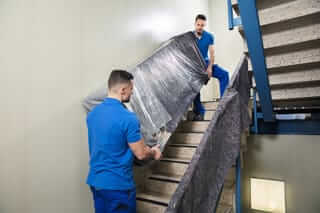Moving is a stressful experience at any age, but the stress felt by older adults can be really quite severe depending on the reasons for the move as well as the lead-up preparations and the actual process.
Moving seniors is a sizable challenge that requires time, patience, and a great deal of organization. As a facilitator, whether family member or professional, one needs to be kind, compassionate, and ready for a wide variety of scenarios to ensure a successful relocation. Professional managers normally come in when a move is “immediate and necessary because of the loss of a spouse, loss of health or ability to live independently,” says Mary Kay Buysse of the National Association of Senior Move Managers.
A home is not just a roof over one’s head – it is usually a place that offers comfort and peace, a haven where one finds refuge from the outside world, a place that reflects your personality, and where memories are created and stored. The longer one lives in the same house or apartment, the more attachment there is and the more complicated is the separation. You can compare it to uprooting a tree to be transplanted into another garden. Thus it’s no surprise that the elderly, who have spent a lot of time, effort, and money to create their “dream home”, spent many years in it, experienced many life-defining moments among its walls, accumulated many treasured possessions, will find it very difficult – both emotionally and physically – to leave their homes and move someplace else.
In addition to that aspect, if the senior decides on his/her own to move for ‘normal’ reasons, and not out of necessity, that’s one thing. It’s the other situations that require more specialized delicate handling — when they can no longer take care of themselves adequately and need to move in with a child, or into an assisted living facility; when their limited retirement income can no longer cover the costs of living in their current location; or when the death of a spouse or family member has affected their financial situation and mental and emotional state, requiring them to depend on family or outside help.
The motivations for moving (aside from normal upgrades, moving for job relocations, family relocations etc) usually fall into the following categories:
- Emergency
- Planned Downsizing
- Retirement Homes
- Hoarding situations — disposals
Emergency moves cover those situations where the sudden loss of a supporting partner, or the rapid progression of an illness for example, makes the current living environment unsuitable going forward. In this case either family (often children) or professional senior move managers need to step in. Management firms charge $40 to $125 per hour and rarely do the actual moving. They do the preparation and before and after chores, from packing and seeing to donations to arranging furniture in the new digs, as well as arranging the hiring of the moving company. Children will be giving freely of their time and money, but of course there is an added emotional cost involved. When an elderly parent transitions from their home to assisted living, independent living, a nursing home or a relative’s home, it can be a stressful experience. Mary Jo Zeller, a senior move manager at Gero Solutions in Chicago, says this move is a major life event. “It’s as monumental as getting married or having a baby, but emotionally, it is more akin to grieving a loss.” Such a move can mean going from a 2,500-square-foot home that a couple has had for 40 years to a 400-foot unit in an assisted living facility.
But most downsizes aren’t emergency operations. They take place for a lot less money, with yard sales, online sales and calls to family, friends and local charities to come for giveaways. It takes more than a moving company to relocate someone who has a lifetime of memories and belongings. From photos and collectibles to dishes and books, these items hold special value and need to be considered when planning a move.
The long preparation process starts of course with acceptance and communication.
Communication And Choice
Moving house is always difficult and stress inducing, even more so when one has to leave a comfortable and welcoming home that has been their personal haven for many years. It is thus expected that there will be much sadness and fear when a senior cannot live in their large family home on their own anymore and needs to relocate – whether to a retirement community or to a smaller place closer to their children.
To convince your aging parents that it is in their best interests to move when they no longer have the strength and the energy to maintain the household (or when they require regular medical care),is without question a tough and heart-rending process. It is, however, the only reasonable solution, so you need to find a way to help them understand the situation and make the transition easier:
Discuss the matter at length – talk with them about why they need to move and where they might relocate to;
Give them time to think it over, grieve their loss, and accept the change;
Point out all the pros of the move – less responsibilities, less work, greater safety, better healthcare, a chance to meet new people and make new friends, a chance to spend more time with you and their grandchildren (if they’ll be moving closer to you), etc.;
Give them as much choice as possible – let them choose their new home (or the living community they’ll be moving to), get them involved in the moving preparations and arranging their new space, let them pick what comes with them, make an adventure out of it as much as possible.
If they are loath to leave their old home, no matter what you say, play the trump card – she’ll be able to see you and her grandchildren much more often! Keep in mind that when seniors are asked to leave their homes, the most common cause of distress is the perceived sense of loss – loss of comfort zone, loss of social circle, loss of control, loss of independence, loss of self. Many seniors pride themselves on never having to depend on anyone. To ensure a smooth transition, you need to reduce this sense of loss and powerlessness – the only way to do so is to be patient and considerate, offer unconditional support, and assure your elderly parents how much you care about them. now is the time to overcome any rifts that may have formed earlier in life and where it’s really helpful if you already had a loving and respectful relationship
They’ve probably lived in the same home for many years, but with age and infirmity their needs are changing. Mom or Dad may have trouble getting around — one fall is all it takes to lead to serious stability issues. They may need help with daily living activities and could probably use some more company. You know that a move to senior living would be wise, but you’re also well aware of the many obstacles that lie ahead on that path. Before jumping right in, do some introspection and think carefully about how you plan to maintain patience, compassion, boundaries and self-awareness throughout this transition.
It’s often best to bring up the subject with your parent when things aren’t going so smoothly at home. Aim for a day when there are plumbing problems or when the bill is due for lawn maintenance. It’ll give you the chance to casually segue into the conversation rather than bringing it up out of the blue. Express your understanding of their desire to age in place but point out the importance of planning for the future and the benefits that come with moving. Don’t seek commitment right away, as it may appear you have already made the decision for them. Help your mom or dad feel that this matter is entirely in their control, and you’re just there for support.
Now that the Move is Decided, here comes the Pain of Preparation
An elderly person’s biggest dread is usually the actual process of moving from point A to point B. Moving is daunting to people of all ages. The idea of sorting, categorizing, dumping (OH NO!), packing up, moving and then unpacking everything collected over the years is somewhat overwhelming. For many seniors, downsizing is synonymous with purging. Collectors, those who hang on to sentimental items, depression-era savers and of course chronic hoarders are often turned off by the possibility of having to rid themselves of even a few possessions.
Sometimes adult children are too frank or even impatient with their parents when it comes to processing furniture, clothing and other personal belongings. In this case the assistance of an elderly friend can be key in the memory release process as some items need to be bid a final goodbye.
Be respectful of your parent’s possessions even if you don’t understand why they value the things they do. The purging process is psychologically daunting for many seniors. They are essentially choosing what aspects of their past they are able to bring with them and which ones they must let go. Memories stand to be lost. Thankfully, there are professional senior movers who specialize in helping seniors get rid of clutter, downsize and relocate. They can help take some of the pressure and emotional pain out of this aspect of the move for both you and your mom or dad.
Take Control of Your Life
It’s still up to you — own your move by minding the tips outlined below.
- Start early.
- Go with a plan.
- Involve the kids.
- Use technology and “life-hacks” — lose the clutter!
- Donate!
- Be a shrewd yard sale manager.
- Packing it in.
“The biggest mistake is waiting until you sell your home or tragedy happens,” says John Buckles, who founded Caring Transitions after enduring his parents’ forced downsize due to failing health. He is now president of the company.
A good rule of thumb: Start cutting down at least a month before you put up your current residence for sale (it will appear larger with less clutter), and at the first signs of declining health.
Hit the “heart of home” rooms first. That’s normally the kitchen, living room and family room, which often are the most cluttered and contain items with the most emotional value and everyday use. Make four piles — keep, donate, give to family members and trash.
From these rooms, work outward. Items furthest away, in sheds, garages and attics, usually have less practical use in the new living space.
Use a space plan of the new home to ensure a “right fit.” When the new, smaller room dimensions are available, experts typically use scale diagrams of the rooms to figure out how items will fit or not. So measure all furniture before deciding what stays and what goes.
“One big problem is seniors thinking their children want that grandfather clock or Waterford when they really don’t,” says Buysse. A heart-to-heart about items’ emotional — and monetary — value is definitely necessary.
Making DVDs of photographs is a really handy alternative to moving boxes of old pictures. “One client had a collection of rare teapots but couldn’t take all 78 with her,” recalls Buysse. “So she took her three favorites with her, sold some, and we made a framed poster of the others that we donated.”
Goodwill and the Salvation Army may appear to be first in line, but items like Civil War collectibles or fancy camera equipment may be better suited for a museum or school. Such legacy gifts can even result in special plaques or recognition aside from handy tax deductions. Even everyday items may benefit little-known organizations. Normal glassware, for instance, will fetch little money at a yard sale. So donate it to a children’s camp or a soup kitchen.
For a better turnout, call it a “moving sale” — especially when selling furniture — and advertise in the local newspaper and Craigslist. Post bright signs on nearby roads (fluorescent poster board costs about $1 a sheet).
Get packing materials from nearby stores or groceries who will be glad to get it off their hands and help you out. Boxes, wrapping material, filler, you name it. With a little asking around, a lot can be had for naught. if you can get family or friends to help you pack, that is the best case scenario. Otherwise pay for professional packing help from a packing or moving company, perhaps on a separate packing day, so that on move day everything can go smoothly and quickly.
You’ve Moved!
The moving company has transported and safely deposited everything in the approximate place it should be. All you need to do is organize your space in such a way that you can be really comfortable and continue your life comfortably. Maybe you are doing this alone or maybe someone is helping you out 100%. Either way, for senior moves, this is actually a very important part of the process, much more so that for the average younger individual that can figure it out themselves. Seniors need to have things calibrated much better so that they can function optimally.
Either you, or your children or family support members, or a professional move management team should have already taken care of change of address notifications with Social Security, post-office, utilities, and anyone else that needs to know. A team of people should help unpack so that nothing is broken (post-move heart ache). You should have time set out to stage old and new furniture and decorations, as well as important memory pieces, so that your transition anxiety is minimized.
At this point you may notice changes you may want made to your new home (if possible), such as a different choice of paint on interior walls. It is a good idea to get a referral and schedule an appointment immediately rather than later down the road. It’s all about comfortable continuity and quality of life.
Here at ABA, we have a strong tradition of good service with senior community members — give us a call if you or your elder family members need to relocate, we’ll go above and beyond to ensure your satisfaction!










